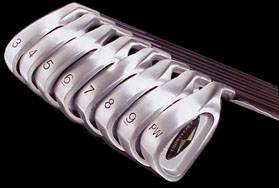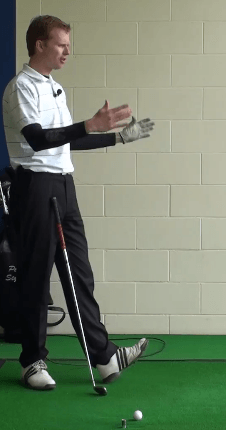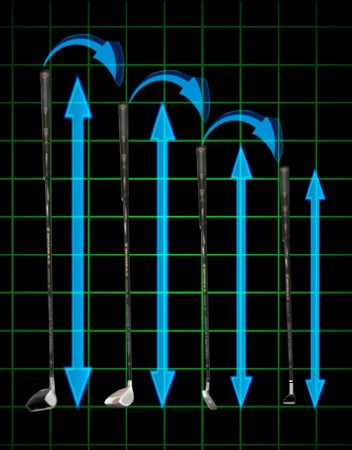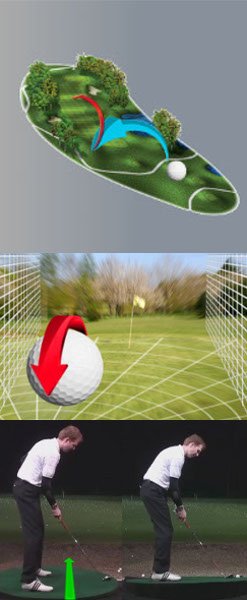
Knowing how far you hit each club in your set is the biggest key to picking the right club for an approach shot to the green. But there are a number of factors to consider besides the yardage.
The wind's speed and direction must be accounted for, plus any uphill or downhill slope. Here are a few other club-selection variables, and how to deal with them:

- Pin located near the back of the green: Since most greens slope from back to front, going long can leave a tough up-and-down when the flag is near the edge. Choose the club that's guaranteed not to fly past the pin. Even if you come up short, you'll have an uphill putt.
- Pin placed on the front: Likewise, hazards often protect the green's front, so you're better off hitting past these flag placements. Pick the club that you know will travel just past the hole, even on a slight mishit.
- Under pressure with adrenaline flowing: When you're pumped up, you'll naturally hit the ball a little farther than usual, so choose the shorter of two options (9-iron instead of 8).
- On cold and/or damp days: The ball won't carry its normal distance, so hit a bit more club than the yardage suggests (8-iron instead of 9).
- Hitting downwind: A tailwind reduces backspin, making the ball fly father and release (bounce and roll) when it lands. Use less club and play short of the flag if possible.
- Hitting into the wind: This equals less carry and more backspin, so the ball will stop quickly. Use more club and try to fly the ball all the way to the pin.
Picking clubs is not a skill you think much about when first getting started in the game of golf.

Instead, you think about things like the mechanics of the swing, the putting stroke, learning proper etiquette, and more. However, at some point in your growth as a golfer, you will come to realize just how important it is to pick the right club for each shot you encounter. After all, even the best swing in the world isn't going to do you any good if you aren't holding the right club.
If golf were played indoors, club selection would be pretty easy. The conditions would always be the same, and you wouldn't have to make adjustments from shot to shot, or from round to round. Once you learned how far you were capable of hitting each of your clubs, that would be it. You'd know your distances, you could trust those distances, and picking the right club would be a breeze. You might not always hit a great shot, but you'd at least be sure that you were using the right stick for the job.
Of course, golf is not played indoors. It is played outside, and that's where things start to get tricky. Conditions are constantly changing outdoors, and you have to respond to those changing conditions properly if you hope to hit good shots. In this article, we are going to cover the main conditions that you need to monitor as you play golf. It might seem overwhelming at first, but don't worry – with some practice and experience, you will become quite comfortable with monitoring these various conditions while you go through a round.
Golf would be a pretty easy game if it were played in perfect, consistent conditions. It will also be pretty boring. It is the changing conditions which make it fun, as no two rounds are ever exactly the same. The best golfers are those who embrace this challenge, using their experience and ability to adapt as quickly as possible as they move from shot to shot. If you are hoping to lower your scores moving forward, learning how to deal with as many conditions as possible is a vital step.
All of the content below is based on a right-handed golfer. If you happen to play left-handed, please take a moment to reverse the directions as necessary.
The Wind

Let's start with the big one – the wind. When you think about conditions that are going to affect your club selection on the course, this is the main issue that comes to mind. When the wind comes up, club selection becomes quite difficult. Not only is it hard to judge the exact speed of the wind while standing out on the course, it is also a guessing game in terms of what will happen next. Is the wind going to stay constant until the shot is complete? Or will it die down, or pick up, before your ball comes down? There are more questions than answers when it comes to wind on the golf course, unfortunately.
On a basic level, you already know how to adjust your club selection in certain wind conditions. For instance, you'll usually need to use at least one extra club when playing into the wind, and you may use one less club when playing downwind. However, there are a number of subtle factors at play here, all of which will impact the club you decide to use. Take a look at the list below to improve your understanding of this subject.
- Consider your ball flight plan. A big key to think about with regard to club selection in the wind is the ball flight you intend to use for a given shot. For instance, let's picture an approach shot that you are playing into the wind. The breeze is quite strong, so you have decided to play a punch shot in order to avoid as much of that wind as possible. While a high shot would likely require at least two extra clubs to reach the target, you may be able to get away with using just one more if you are going to hit a punch.
- Take a look around. While the conditions might be windy overall, that doesn't necessarily mean the wind will have a profound impact on the shot you are hitting. In order to determine how much wind to play for in a certain situation, you'll want to look around and assess the surrounding terrain. Are there any big trees which may block the wind to a degree? Are you sitting down in a protected valley, or up on an exposed point? It will take some experience to learn how to evaluate each situation on its own merit. Obviously, if you play the same course over and over again, you will become familiar with which shots are impacted the most by the wind, and which seem to be protected.
- Check your lie. At first, it might not seem like the lie of the ball would have a lot to do with how it will be impacted by the wind. However, in some cases, your lie will have a great impact on how you need to play this shot – and on which club you should use. In this case, we are talking about the slope of the ground under the ball more than anything else. If the ground is sloped up toward the target, your ball is naturally going to want to fly higher than normal. This means the wind will have a powerful impact on the shot. On the other hand, if you are playing from a downslope, you should be able to keep your shot down nicely, and the wind shouldn't have as much of an impact.
- Spin matters. One last thing to think about is the spin that you expect to place on the golf ball. A ball that has a high rate of backspin is likely to fly high in the air, and the wind will have a greater impact on its flight. This is a major problem when playing into the wind. If you hit an approach shot into the wind with a high rate of spin, that shot could come down way short of your intended target. On this point, we can get back to the subject of the lie of the ball. If your ball is sitting on a clean fairway lie, you should get plenty of spin and you will need to worry about the shot ballooning into the air (when playing into the wind). On the other hand, an into-the-wind shot from the rough is not quite as tricky, since the ball will come out with less spin overall.
Playing golf in the wind is always going to be a challenge. In addition to the difficulty of picking the right club for each shot, it can also be tough to make a solid swing while you are being blown around. A big part of playing well in these conditions comes down to experience. As you play more and more golf in the wind, you will naturally develop your skills. Pay close attention to how each of your shots reacts to windy conditions and use that information to improve moving forward.
The Turf

The wind is one of the primary factors that will influence your ball once it leaves your club face. But what about when it comes back down? Once the ball lands, it is going to be influenced by the conditions of the turf. This is an important element to consider because it can have a great deal to say about which club will be right for the job. After all, a shot played from 150-yards on firm turf is a different challenge than a shot of the same length played on soft turf.
Let's take a look at some of the things you will need to consider with regard to the turf when picking clubs.
- The first bounce. The bounce you expect to receive when the ball first lands back down on the ground is going to have a lot to do with the eventual distance of the shot. Do you think the ball is going to bound high up into the air, or will it pretty much stick to the turf? The answer to this question is going to have to do mostly with weather. If the course has received significant rain lately – or if it has been overwatered – the ball isn't going to bounce much. Only when you are playing on a dry course should you plan on getting much of a bounce. Of course, the type of shot you are playing is going to have a big impact here as well, since long shots are going to be more likely to take a long bounce than will shorter shots with higher spin rates and higher trajectories. Judging the first bounce after the ball lands can be a tricky task, but it is one of your main objectives as a golfer.
- Estimated stopping power. When your ball lands, it is almost certainly going to have some degree of backspin in progress. That backspin is going to work to stop the ball at least slightly, but the amount of impact the spin has on the ball will depend largely on course conditions. If the turf cut low, such as would be the case on the putting surface, the spin will have a chance to do its job. In longer grass, however, you can't rely on as much stopping power from the backspin. Think about where you are planning to land your ball, and think about how the course has been manicured, when deciding how much stopping power you will get. Then, add that factor into your club selection. For instance, if you think a shot is going to stop quickly due to backspin, you may need to use one more club than if you are expecting a big bounce and plenty of roll.
- How's your lie? So far, we have been talking about the impact of the turf where your ball is going to land, but that's only part of the issue. In addition, you need to think about the turf below your ball. If you have a lie on a soft patch of the course, you will be more likely to catch the shot a bit fat, and the ball may come out a little slow. That means it will be harder to live up to your distance potential, and you may want to err on the side of using extra club. On the other hand, if the turf is firm and dry under your ball, it's likely that the club will tear through the hitting are with plenty of speed. As a result, the ball should cover plenty of distance, and it's unlikely you'll want to use an extra club. In fact, in some cases, you may want to use a little less club to account for your fast lie.
From the moment you arrive at the course for your round, you should be constantly checking the turf conditions. You will need to get comfortable with the turf when getting started, and you will also need to watch for changes along the way. As the day wears on, it is possible that the turf conditions will change, especially if rain moves in or if a hot sun is beating down on the course. You need to have a strong understanding of how the turf is playing if you want to pick the right club.
The Temperature

When you think about the temperatures that you will encounter on the golf course, you usually think about your own personal comfort first and foremost. On cold days, you will be thinking about wearing enough clothes to stay warm all round long. Or, on a hot summer day, you will be thinking of ways to cool off and stay hydrated. Either way, you are going to pay attention to the temperatures because the weather has a profound impact on your ability to enjoy the day.
In addition to impacting your personal comfort, the temperature during your round is also going to play a role in club selection. Generally speaking, the ball is going to fly farther on a warm day than it will on a cold day. When the changes are modest, there isn't going to be much of a noticeable difference. For instance, if you play one round with temps around 60*F, and another round with temps of 70*F, any difference in distance is going to be negligible. However, when the temperatures get closer to the extreme end of the spectrum, the impact will be obvious. Playing golf on a day with temps of 80*F or higher, or temps lower than 50*F, will usually require you to make some club selection adjustments.
So, why do your distances change as a result of weather? There are a couple of things to keep in mind here. For one thing, the ball is simply going to be harder to compress when it is colder. The cold temperatures will dampen the transfer of energy at impact to some degree, and the ball is not going to leave the club as quickly as it would on a warmer day. Experienced golfers can even feel the difference at the point of contact, as impact just doesn't feel the same when temperatures are low.
Beyond the science of trying to hit a ball in cold temperatures, there is also the issue of your body and swing to consider. When the weather is cold, you are sure to be wearing more clothing than you would wear on a hot day. Those clothes may inhibit your turn, and make it hard to produce maximum swing speed. Also, your muscle may feel tight in the cold weather, again making it hard to turn. In the end, your swing speed could be down a few miles per hour – or more – and your distance will be impacted further.
On a hot day, the story is exactly the opposite. You are likely to be wearing light clothing, so there will be no limitations placed on the dynamics of your swing. Your muscles should be loose and feeling good, with the warm aim helping to keep your entire body relaxed and ready to perform. These conditions usually lead to plenty of long shots. It's no surprise that so many golfers love to play in hot weather, as the ball seems to fly forever!
When it comes time to pick a club for a given shot, keep the temperatures in mind. This is usually not going to be as powerful of a force as the wind on a breezy day, but it is definitely something to monitor. With time, you will get better and better at understanding what the temperatures are going to do to your ball flights, so you will be able to pick the right club more frequently.
Other Tips

We have covered three key club selection issues with regard to playing conditions so far in this article – wind, turf, and temperature. For this last section, we want to step away from the topic of conditions to simply talk about club selection on the whole. The tips listed below should help you pick the right club more often, no matter what conditions you happen to be facing.
- Stay on the safe side. It is common to be stuck picking between two clubs for a given shot – frequently an approach shot. When that is the case, you can use danger as the tiebreaker. In other words, opt for the club that is going to keep you the farthest away from big trouble. For example, let's say you are trying to decide between hitting a six iron or a seven iron for an approach shot into the green. Either club could work, depending on the kind of swing you make. However, there is a water hazard short of the green on this particular hole. With that in mind, the six iron is probably the right choice. The added distance potential will give you some margin for error. Even if you hit the ball a little bit past the hole, you will be safely away from the hazard. Sure, you might be able to get away with the seven iron if you make a great swing, but even a minor error could cause your ball to drop into the drink.
- Trust your instincts. Sometimes, you just 'feel' which club is the right one for the job. When that happens, go with it unless there is an obvious reason to make a different choice. It is important to trust your club selection when you stand over the ball at address, and going with the club that your instincts tell you is right will certainly boost your self-belief.
- Ignore the driving range. For club selection purposes, the driving range is effectively useless. Make no mistake – the driving range is tremendously useful for other things, like improving your swing technique, but it isn't going to tell you much about how far you hit the ball. Range balls are usually constructed differently than the balls you will use on the course, and they may have been hit hundreds of times as well. As far as club selection goes, the only information you should trust is that which is gathered on the course during actual rounds of golf.
You will become a better golfer if you are able to improve your ability to pick the right club for each situation. You'll never get it right every time, of course, as there are too many variables in play to be perfect. How4ever, understanding how conditions play a role in club selection will help you dial it up properly on a more consistent basis. We hope the advice offered in this article helps you take a step in the right direction. Good luck!






